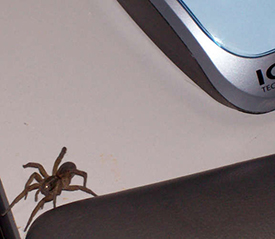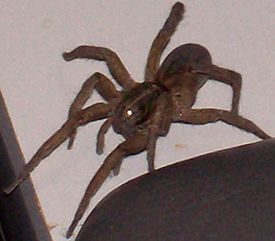

I was cleaning up files on a backup drive, opened the "Old Animals" folder, and noticed the photos above.
A few years ago, I had a wolf spider that visited me in my cellar office every night.
Wolf spiders are the most common spider species on the planet, and they're mainly outdoor critters. They head indoors as fall approaches, seeking warmth, water, and food, and are solitary, lone hunters. They hide under things most of the time, out of sight, emerging at night to do their hunting.
If you're going to have spiders in your house, wolf spiders are the ones to have- they're benign and beneficial. They don't spin webs to capture prey. Like their lupine namesake, they use their speed and agility to pursue and subdue their prey. They are reclusive, but shouldn't be confused with the nasty brown recluse spider. Wolf spiders will bite, but only if threatened or trapped against the skin. Wolf spider venom isn't poisonous to humans, but some people may experience an allergic reaction. Unlike other multi-legged creatures that infest our homes, they don't transmit diseases communicable to humans.
Notice the glowing spot of light on the spider in the photo? Like other spiders, they have eight eyes. But unlike most spiders, they have excellent vision. The eyes are arranged in three rows: four small eyes in the bottom row, two medium eyes in the top and two large eyes in the middle. Like dogs and cats, wolf spiders have a retroreflective layer of tissue behind the retina called the tapetum lucidum, giving them exceptional night vision. You can tell if you have wolf spiders by shining a flashlight at the floor with the room darkened. If you do have one, you'll see two little glowing eyes peering at you.
My wolf spider appeared, appropriately enough, right before Halloween. I had returned to my desk and looked down to grab the computer mouse, only to spot a rather large arachnid staring at me with glowing eyes. I quickly removed my hand from her vicinity and sat quietly, watching her watch me. After a minute, she leisurely turned around and disappeared under a workstation shelf.
The next night at the same time she reappeared and assumed her position on the mouse shelf. It became a daily routine. She'd pause for a minute or so, watching me with her glowing orbs. Then she'd head back out under the workstation shelf, resuming her mission of pest annihilation. Call it anthropomorphizing, but it was as if she was checking in before her shift to let me know she was on the job.
Shortly before Christmas her visits ended, and I never saw her again. Female wolf spiders can live two to three years, and I didn't know how old she was when she originally reported for duty. She may have relocated to another area of the house and had the good sense to remain hidden from the seven dogs and two cats who shared the residence at that time.
If you want to capture and release the spiders in your house, well, be humane about it. If you put them out in cold weather, they probably won't last a day. In the spring and summer, it's okay to banish wolf spiders to the outside. It's their native environment.
But the other little web spinners you spot in the house? They're called house spiders for a reason. "Some house spider species have been living indoors at least since the days of the Roman Empire, and are seldom to be found outside, even in their native countries," writes Rod Crawford, curator of arachnid collections at the Burke Museum of Natural History & Culture in Seattle and noted debunker of spider myths. "They usually spend their entire life cycle in, on or under their native building."
"You can't put something 'back' outside that was never outside in the first place," he writes. "Although some house spider species can survive outdoors, most don't do well there, and some (which are native to other climates) will perish rather quickly when removed from the protective indoor habitat. You're not doing them a favor." In general, Crawford says, only about five percent of the spiders you see inside a building have ever set foot outdoors.
Unless you have a true infestation and a large number of highly visible spiders, the best policy is to perhaps learn to live with them. Mother Nature designed them to live with us. They're not freeloaders; they work diligently to eliminate potentially disease carrying pests, and unlike insects, won't get into the food in your pantry. Remember the old English proverb:
If you wish to live and thrive,
Let the spider run alive.
Categories: Spiders
Home KGB on Bluesky KGB on Substack
KGB Stuff Commentwear E-Mail KGB
Donate via PayPal

















